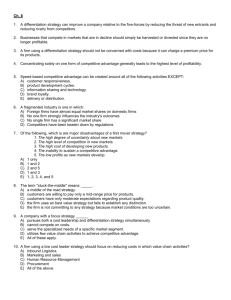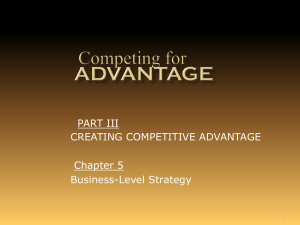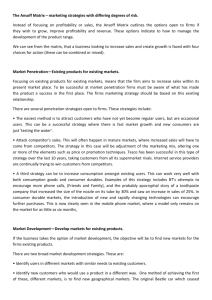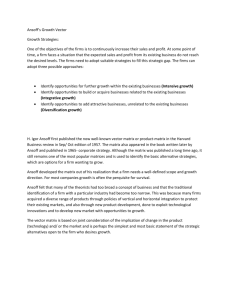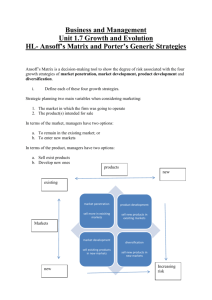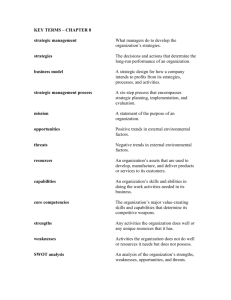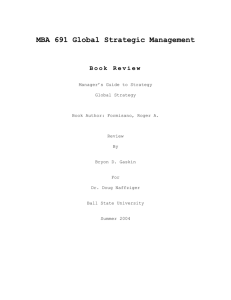Strategic Management
advertisement
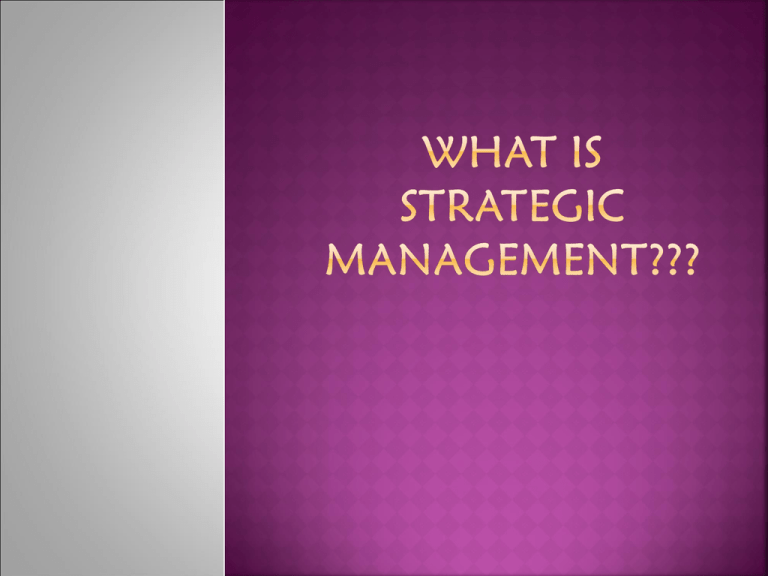
Strategic Management The set of decisions and actions used to formulate and implement strategies that will provide a competitively superior fit between the organization and its environment so as to achieve organizational goals. The general plan of major action by which an organization intends to achieve its long-term goals. Three general categories: 1. 2. 3. Growth – can be promoted internally by investing in expansion or externally by acquiring additional business divisions. Stability (pause strategy) – that the organization wants to remain the same size or grow slowly and in a controlled fashion. Retrenchment – that the organization goes through period of forced decline by either shrinking current business units or selling off or liquidating entire business. a separate grand strategy as the focus of global business. Three global strategies: 1. Globalization – the standardization of product design and advertising strategies throughout the world. 2. Multidomestic strategy – the modification of product design and advertising strategies to suit the specific needs of individual countries. 3. Transnational strategy – a strategy that combines global coordination to attain efficiency with flexibility to meet specific needs in various countries. Choosing how the organization will be different. Strategy The plan of action that prescribes resource allocation and other activities for dealing with the environment and helping the organization attain its goals. To remain competitive, companies develop strategies that focus on: 1. Core competence 2. Synergy 3. A business activity that an organization does particularly well in comparison to competitors. The condition that exists when the organization’s parts interact to produce a joint effect that is greater than the sum of the parts acting alone. Value Creation The heart of strategy. Value can be defined as the combination of benefits received and costs paid by the customers. Corporate-Level The level of strategy concerned with the question, “What business are we in?”. Pertains to the organization as a whole and the combination of business units and product lines that make it up. Business-Level Strategy The level of strategy concerned with the question, “How do we compete?”. Pertains to each business unit or product line within the organization. Functional-Level Strategy Strategy The level of strategy concerned with the question, “How do we support the business-level strategy?”. Pertains to all of the organization’s major departments. 1.What is Ansoff matrix? The Ansoff Growth matrix is a tool that helps businesses decide their product and market growth strategy. Ansoff’s product/market growth matrix suggests that a business’ attempts to grow depend on whether it markets new or existing products in new or existing markets. Market Penetration: Here we market our existing products to our existing customers. This means increasing our revenue by, for example, promoting the product, repositioning the brand, and so on. However, the product is not altered and we do not seek any new customers. This is usually used for increasing the market share of a company.For example if Pepsi can market their product better than Coca-Cola they will make a better profit than Coca-Cola and they will increase their market share. Market Development Here we market our existing product range in a new market. This means that the product remains the same, but it is marketed to a new audience. Exporting the product, or marketing it in a new region, are examples of market development. This strategy can be exampled like this if ColaTurca a Turkish company who decides to expend their product to a new region such as England so they start to sell their cola in there This is a weak strategy if there is so many rival companies at the place such as Pepsi and Cola in England Product Development This is a new product to be marketed to our existing customers. Here we develop and innovate new product offerings to replace existing ones. Such products are then marketed to our existing customers. This often happens with the auto markets where existing models are updated or replaced and then marketed to existing customers. This one in Coke companies came up with pepsi with Pepsi Blue and Pepsi Twist This development increased pepsi’s Profit by %15 Diversification This is where we market completely new products to new customers. There are two types of diversification, namely related and unrelated diversification. Related diversification means that we remain in a market or industry with which we are familiar. For example, a soup manufacturer diversifies into cake manufacture (i.e. the food industry). Unrelated diversification is where we have no previous industry nor market experience. For example a soup manufacturer invests in the rail business. Porter's Generic Strategies A firm positions itself by leveraging its strengths Michael Porter has argued that a firm's strengths ultimately fall into one of two headings: cost advantage and differentiation. By applying these strengths in either a broad or narrow scope, three generic strategies result: cost leadership, differentiation, and focus This generic strategy calls for being the low cost producer in an industry for a given level of quality. The firm sells its products either at average industry prices to earn a profit higher than that of rivals, or below the average industry prices to gain market share. In the event of a price war, the firm can maintain some profitability while the competition suffers losses Even without a price war, as the industry matures and prices decline, the firms that can produce more cheaply will remain profitable for a longer period of time The cost leadership strategy always targets a broad market. Access to the capital required to make a significant investment in production assets; this investment represents a barrier to entry that many firms may not overcome. Skill in designing products for efficient manufacturing. High level of expertise in manufacturing process engineering. Efficient distribution channels Other firms may be able to lower their costs as well. As technology improves, the competition may be able to leapfrog the production capabilities, thus eliminating the competitive advantage. Several firms following a focus strategy and targeting various narrow markets may be able to achieve an even lower cost within their segments and as a group gain significant market share. A leading cost strategy for McDonalds is the ability to purchase the land and buildings of its restaurants McDonalds also developed a strong division of labor for its production processes, tight management control and product development strategy. Creating a strong top-down style of management is another leading cost strategy for McDonalds Using fewer in-store managers allows the company to hire lower-wage workers to complete tasks. After nearing complete bankruptcy in the 1980s, Apple clawed its way back into the personal electronic industry through smart business practices and highly desirable consumer goods. Apple uses low-cost direct materials to develop the cheapest consumer goods possible. Creating long-standing business agreements with companies like AT&T for web hosting and other applications helps Apple stay focused on developing products rather than Internet hosting or access A differentiation strategy calls for the development of a product or service that offers unique attributes that are valued by customers and that customers perceive to be better than or different from the products of the competition. The value added by the uniqueness of the product may allow the firm to charge a premium price for it. The firm hopes that the higher price will more than cover the extra costs incurred in offering the unique product. Access to leading scientific research. Highly skilled and creative product development team. Strong sales team with the ability to successfully communicate the perceived strengths of the product. Corporate reputation for quality and innovation. Imitation by competitors and changes in customer tastes Various firms pursuing focus strategies may be able to achieve even greater differentiation in their market segments. Medimix herbal soap differentiated itself on the herbal plank two decades back when there were only synthetic soaps. A new brand of herbal soap launched in today’s context has to probably define the herbal qualities through an enhanced mix of ingredients to convey the differentiation because `herbal’ is the proposition of several brands both new and old. The established Medimix brand is currently running a campaign, which conveys the brand benefits through appropriate imagery. The focus strategy concentrates on a narrow segment and within that segment attempts to achieve either a cost advantage or differentiation. The premise is that the needs of the group can be better serviced by focusing entirely on it A firm using a focus strategy often enjoys a high degree of customer loyalty, and this entrenched loyalty discourages other firms from competing directly. Because of their narrow market focus, firms pursuing a focus strategy have lower volumes and therefore less bargaining power with their suppliers However, firms pursuing a differentiation-focused strategy may be able to pass higher costs on to customers since close substitute products do not exist. The firm is able to tailor a broad range of product development strengths to a relatively narrow market segment that they know very well. Imitation segments and changes in the target It may be fairly easy for a broad-market cost leader to adapt its product in order to compete directly Other focusers may be able to carve out sub-segments that they can serve even better. By successfully adopting the 'focus' strategy since 1997, PepsiCo has emerged as the second largest consumer packaged goods company The company has significantly strengthened its competitive position in the beverages segment. By acquiring leading beverages' company like Tropicana products (July 1998), South Beach Beverage Company (October 2000) and Quaker Oats (December 2000) Industry Cost Force Leadership Differentiation Focus Entry Barriers Ability to cut price Customer loyalty can in retaliation deters discourage potential potential entrants. entrants Buyer Power Ability to offer lower price to powerful buyers. Large buyers have less Large buyers have less power power to negotiate because to negotiate because of few of few close alternatives. alternatives. Supplier Power Better insulated from powerful suppliers. Better able to pass on through suppliers, price increases to customers. Suppliers have power because of low volumes Customer's become attached to differentiating attributes, reducing threat of substitutes. Specialized products & core competency protect against substitutes. Brand loyalty to keep customers from rivals. Rivals cannot meet differentiation-focused customer needs. Threat of Can use low price Substitute to defend against substitutes. Rivalry Better able to compete on price. Focusing develops core competencies that can act as an entry barrier.
